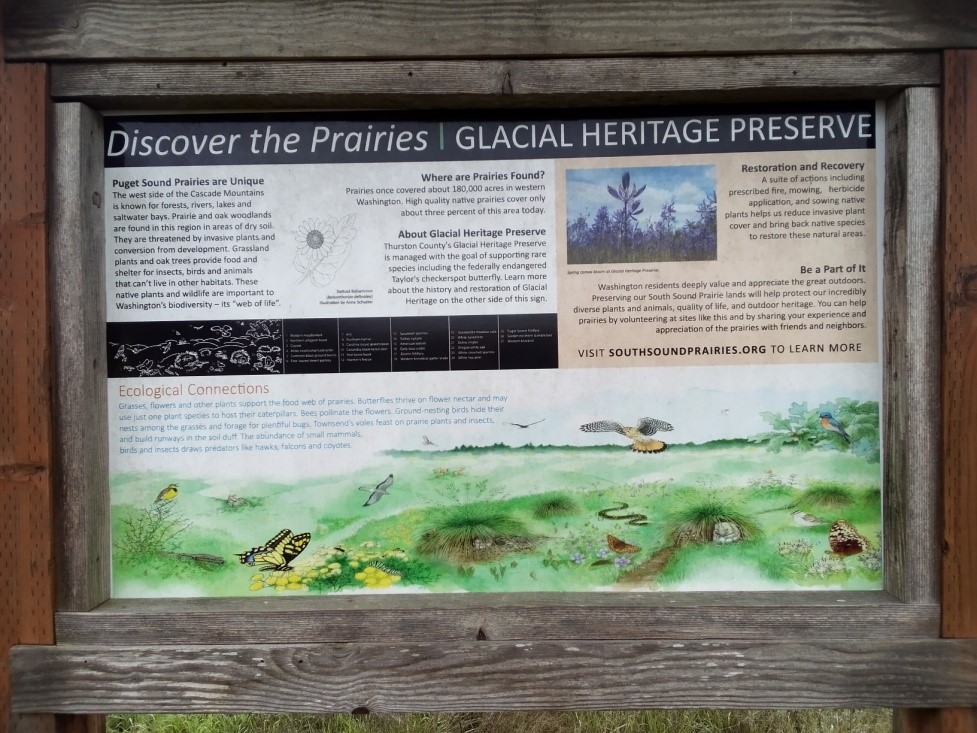GLACIAL HERITAGE PRESERVE AND ITS STORY
Kathleen Snyder
Black Hills Audubon has taken on the monitoring and maintenance of the bluebird nest boxes at Glacial Heritage Preserve. This had me wondering about how Thurston County had acquired this amazing place and what their plan was for its future. In researching this, I talked with Lawrence Jacobs who was responsible for choosing the Preserve’s name and Sanders Freed whom you will hear about later.
The acquisition of this property began in 1983 when a group of citizens approached the County Commissioners asking that they preserve some of our unique prairie landscape. The process of acquiring Glacial involved government, community and business leaders in a complicated land swap. The names of some of the wonderful folks who made this happen are state representative Barb Holm, Commissioner of Public Lands Brian Boyle, Realtor Patricia Williams, Partners Financial Inc. (PFI), Hans Littooy and Jack Davis. In 1988, the land swap was completed between the WA Dept. of Natural Resources, Thurston County and PFI. We ended up with a piece of property that was over 1,000 acres and covered with Scotch broom. (As an aside, Hans Littooy received our first BHAS Jack Davis Conservationist of the Year Award in 1988 for his effort on this.)
Look at it now! It is almost back to pristine native short-grass prairie with abundant birds, mammals, wildflowers, and bugs. This has been the result of years of restoration and brings me to Sanders Freed.
Sanders is a superhero in the guise of a habitat restoration expert. With only 2 employees and some dedicated volunteers, Sanders is supervising the restoration or management of 15 (!) properties either owned or managed by the Center for Natural Land Management (CNLM). In addition, CNLM is on the cusp of acquiring two more properties in Oregon that Sanders will manage. And he has to write the grants to fund this work. One might ask “How the heck does he do it?”
First, his education prepared him for this. He received his undergraduate degree from Oregon State University and a Masters of Environmental Studies from Evergreen State College. Second, he has a passion for wildlife and the habitat they need to survive and thrive. Visit his home and you will see multiple, very active, birdfeeders plus a workshop where he builds bat boxes, Purple Martin nest boxes, and whatever else is needed. Over last winter, he built and installed 50 Purple Martin nest boxes. And third, I strongly suspect that Sanders is willing to put in more than 40 hours per week to get it all done.
CNLM was founded in 1990 in California and incorporated as a nonprofit tax exempt organization. It protects sensitive biological resources through science-based stewardship of conservation lands in perpetuity. It assures this perpetual protection by establishing stewardship endowments. Sanders joined CNLM in 2011. His responsibilities include managing and implementing restoration activities on numerous private, public and partner agency lands in Thurston County and elsewhere. The majority of his efforts focus on the restoration of degraded prairie/oak lands for the reintroduction or retention of imperiled species including the Mazama pocket gopher and Taylor’s checkerspot butterfly. (Visit CNLM’s website for more information and volunteer opportunities: https://www.cnlm.org/)
Glacial Heritage Preserve is one of Sander’s projects. He explains that the WA Department of Fish and Wildlife owns 80 acres of this 1,110 acre property. The Nature Conservancy was first to take on the restoration; CNLM became involved around 2010. The manual labor of volunteers plus controlled burns, the judicious use of herbicides, and planting native species has turned the property around.
Please note that Thurston County pays no money to CNLM for their management and restoration work; this is all funded with grants and donations.
As you may be aware, the county is in the process of asphalting a new multi-use trail called Gate Belmore. This trail will pass very close to Glacial Heritage Preserve and Sanders predicts this will spur the county into opening Glacial to the public. He will be promoting the use of responsible stewardship practices for this – staying on trails, no dogs (or, at least, leashed dogs), no bikes, etc. BHAS will remain vigilant in this regard and submit our comments to the county when possible.
As for the future, Sanders is exploring the possibility of introducing breeding Vesper Sparrow and Streaked Horned Lark populations to Glacial as well as attempting the introduction of Taylor’s checkerspot butterflies. These species are listed as threatened or endangered. In the meantime, the BHAS Bluebird team will continue monitoring and maintaining the nest boxes out at Glacial. It is an honor to be part of this restoration effort and work with superhero Sanders.








